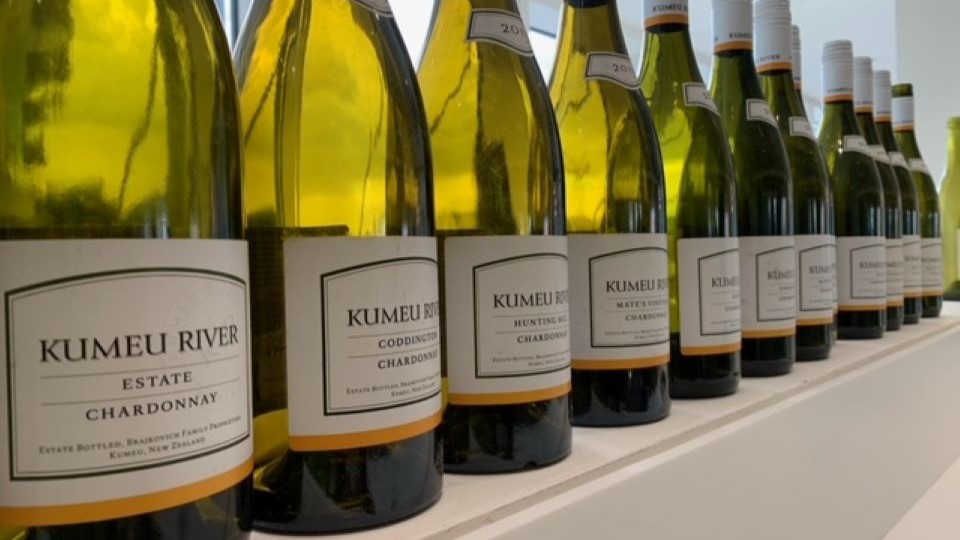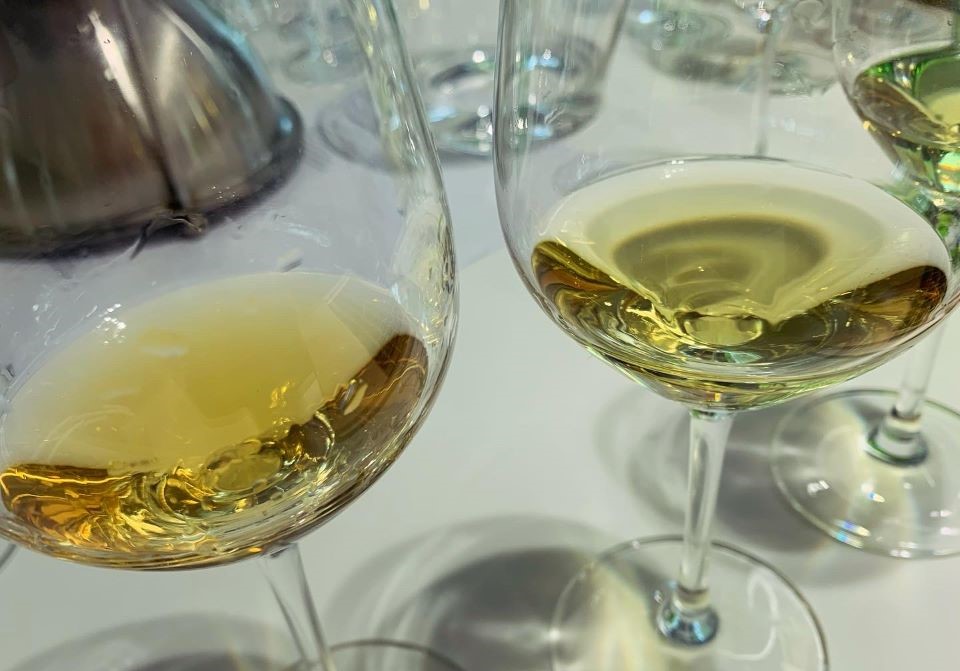Browse using the new Vinous website now. Launch →
Printed by, and for the sole use of . All rights reserved © 2015 Vinous Media
Kumeu River: The Kiwi Dream
BY REBECCA GIBB MW | SEPTEMBER 25, 2024
It’s been 80 years since the Brajkovich family bought a block of land in the Kumeu village. They were one of many Dalmatian families that left their homeland in the Austro-Hungarian empire in search of a new life in west Auckland. Scrimping and saving on the Kauri gum fields to the north and working in local vineyards, Mick and Katé Brajkovich, with their son Maté Brajkovich, paid the deposit to start their Kiwi dream in 1944.
In 2024, the family name is not just known in West Auckland, nor is it just a memory of a family that left its home village. Kumeu River is known in Sydney, New York, London, Tokyo and beyond. Their humble dream of growing grapes, strawberries and pumpkins in a land far away from their coastal village in what is now Croatia has been far exceeded, and they have become a globally recognized wine producer in the past 40 years.

Today,
Kumeu River stands as tall as its 6’ 4” winemaker, Michael Brajkovic. Leading
the direction of its wines, Brajkovic has specialized and gained Kumeu notoriety
for its array of Chardonnays, particularly its three single vineyards: Coddington,
Hunting Hill and Maté’s. The latter is a tribute to Maté Brajkovic, Michael and
Paul’s father, who passed away in 1992 at the age of 66, leaving Michael, who
had become New Zealand’s first Master of Wine a year earlier, to forge the
family’s winemaking direction, while brother Paul is the marketing director, focusing
on securing Kumeu River in the international market.
Maté Brajkovic couldn’t have left his winery in better hands. But then again, the elder Brajkovic had been preparing his four children for succession from an early age, working in the winery, on the bottling line, and even helping sell on weekends to pass trade. Michael Brajkovic recalls standing on a box at age three, ready for the call from his father to switch a pump on and off.
This year, Michael Brajkovic, like his father before him, became a New Zealand Wine Fellow, the equivalent of the Hall of Fame. The MW is the country’s most respected Chardonnay producer and the man everyone looks at for guidance when it comes to this white variety. Brajkovic was at the top of the list of speakers at the inaugural gathering of the Marlborough Chardonnay producers seeking to elevate their offering in 2023.
New Zealand’s north island was wine’s original heartland before scientific studies in the 1970s disproved the belief that the South Island was too cool to grow wine grapes. When Maté Brajkovic planted his first Chardonnay in this corner of West Auckland in the 1960s, there was not a single vine in the Marlborough ground, some 800 kilometers to the south. Burgundy and Marlborough (in the South Island) might be thousands of miles apart, but their climates share similarities. There is very little difference between the two when it comes to growing season temperatures (15.1˚C in Burgundy, 15.2˚C in Marlborough), Growing Degree Days (1,068 vs. 1,118) and annual rainfall (approximately 700mm for both). Admittedly, there are many differences too—annual sunshine, UV radiation, soil types and viticultural practices, to name but a few—but there are enough indicators to show that Chardonnay should be at home in this part of New Zealand. However, the country’s go-to Chardonnay winery remains in the north.
Onlookers are amazed by why the country’s most ambitious haven’t sought to emulate Kumeu River and plant close to the source of success. It’s a case of location, location, location. On paper, West Auckland is far from the ideal climate. High rainfall and humidity can be an issue, mitigated by a lyre trellis system and enthusiastic leaf plucking. But for most, real estate prices have proved decisive. House prices and land values have risen inexorably on the outskirts of Auckland. As a result, many of the original West Auckland wine families have relocated, finding greater choices and better-priced vineyard land in a climate more conducive to viticulture, such as Hawke’s Bay or across the Cook Strait in Marlborough. Paul Brajkovich says, “We bought 100 acres off Corbans Wines in the early 1980s because they wanted to go elsewhere, and we still have 40 acres of that vineyard.”
It was about this time when a young Michael Brajkovic returned from Roseworthy College in Adelaide with a winemaking degree in hand. Little did the family know that Chardonnay would be the variety that would become an international success. The family was experimenting with a fruit salad of varieties including Merlot and Cabernet Franc and Chardonnay clones 5, 6 and Mendoza. As it became clear that their direction was more Burgundian than Bordelais, the diversity of its Chardonnay plantings increased. The Chardonnay Estate, perhaps the best value Chardonnay that will ever grace your glass and pleasantly surprise you with its ability to age for at least a decade under screwcap, is the most diverse cuvée of clones 6, 15, 95, 548 and 1066. Clone 15 is wholly used for both Coddington and Hunting Hill (planted in 1994 and 2001, respectively), while Maté’s is exclusively a Mendoza clone. This gives it a distinctive personality: Mendoza suffers from hen and chicken, leading to uneven berry size and uneven ripeness. As a result, it lends a tangy, sweet and sour nature to the wines—think Haribo Tangfastics.
Tasting
through vintages of Kumeu River Chardonnays from 2020 back to 2002, Mendoza is
part of Maté’s identity. What’s also apparent throughout the flight is that sinew and rich substance embodies Maté’s. It positively absorbs its 30% new
oak, the most of any single vineyard cuvée at Kumeu, with Mercurey and Seguin
Moreau coopers providing a sophisticated layer of complexity but not
overpowering when young. Before use, the barrels are all conditioned with hot
water to ensure only alcohol-soluble oak compounds are extracted to improve
integration. It seems to do the trick.
While Maté’s has long been the jewel in the Kumeu crown, the 2021 and particularly 2022 vintages of Hunting Hill have challenged Maté’s for supremacy. Planted in 2001 on a cool, breezy site, Hunting Hill’s personality is clear in the glass, even in its debut 2007 vintage, when the vines were only six years old. While its concentration and depth weren’t there in its earliest renditions, by the time the legendary vintages of 2013 and 2014 came along, the Hunting Hill had already shown greater substance and firepower, and the vine age kept coming. Sitting on a cooler, breezier site with an iron pan, Hunting Hill offers tension, lime juice, floral and briny notes. Maté is a richer, more muscular style that is satisfying and chewy, but Hunting Hill may soon be without a rival. Maté’s vineyard has long had leafroll virus making, which delays ripening and shortens the vine’s life. Paul Brajkovich says, “We did think about ripping the vineyard up at 15 years old, but then we looked at the wine, and we thought: ‘We’ll keep it going, and it’s now 34 years old.’” There is a plan in place to replace it. Their latest vineyard acquisition, Rays Road in Hawke’s Bay, is the breeding ground for non-virused Mendoza Chardonnay clones and will provide the replacement vineyard stocks for Maté's.

Two glasses of 2002 Mate’s Chardonnay: the left sealed with a cork closure, the right with a screwcap
Meanwhile, Coddington is the third of the three single vineyards, sourced from a site owned and planted by a couple—the Coddingtons—in the late 1990s. It is 5km down the road from Kumeu River’s winery and is a north-facing sun trap, making it the warmest of the trio of single vineyard cuvées. Sitting on clay, it is the fullest in body and is often welcoming in youth with no hard edges. This is the only cuvée that is matured in barrels from Saint-Romain cooper Claude Gillet, providing a distinctive smoky character that the other wines don’t display. While you can open it relatively young for its suppleness, the 2014 shows that there is plenty more still to come after close to a decade in bottle.
With respect to evolution, it’s clear that these white wines have a consistent and extended lifespan under screwcap, which was evident when a pair of 2002 Maté’s were poured alongside each other. One was oxidized and corked, and the other was pristine and holding up well in comparison. It was almost an advert for screwcap manufacturers. But Paul Brajkovich explains: “If you’ve got a really good cork, you don’t see any difference between the screwcap and cork.” Unfortunately, living at the bottom of the earth and trying to get hold of corks made on the other side of the world has proved almost impossible. It was almost as if geographical isolation put them at the back of the queue for decent corks. “We lived with 6% cork taint in the mid-1980s, then in the late 1990s, we were seeing 20-30%. The worst example was when we isolated 200 cases of Maté’s. There were two of us opening the bottles and two of us tasting. We threw away 30% of the wine due to cork taint, but one in 20 would be really good, and we thought, ‘Each one should taste like this.’”
While
the 2004 and 2007 vintages looked like work was still in progress, and it is
unfair to judge the frost-affected 2010 wines, such was their tiny quantity,
there was a leap in quality in 2013 and 2014. Admittedly, they were great
vintages. Two thousand thirteen was the vintage of a lifetime until 2014 came
along and vied for the same title in the same way as Bordeaux in 2009 and 2010.
Still, there’s a step-up in class in the intensity of ripe fruit and the
definition of the site that can’t be denied. Across the range, even at its entry-level, the judicious handling of
fruit, lees and sensitive oak offer balanced, layered, understated styles.
It is difficult to deny Kumeu River its place at the global Chardonnay table. It has earned its seat by taking on the best of Burgundy in blind tastings and coming out favorably time and time again. The trickle-down effect hasn’t quite trickled as fluidly as it ought. Wine merchants and drinkers rarely venture beyond Kumeu River, making it their Kiwi Chardonnay start and finish line. The world should sit up and take notice of New Zealand Chardonnay beyond Kumeu River. It would be another valuable legacy left to the wine community by Mick, Maté and Michael Brajkovic.
© 2024, Vinous. No portion of this article may be copied, shared or re-distributed without prior consent from Vinous. Doing so is not only a violation of our copyright, but also threatens the survival of independent wine criticism.
You Might Also Enjoy
New Zealand’s Latest Red Releases: Growing Up, Rebecca Gibb MW, May 2024
2023 New Zealand Whites: The Cyclone Vintage, Rebecca Gibb MW, April 2024
All Change: New Zealand Reds, Rebecca Gibb MW, April 2023
New Zealand Whites: The Great Divide, Rebecca Gibb MW, April 2023
